Industrial Logic Integrated Circuits Market Size
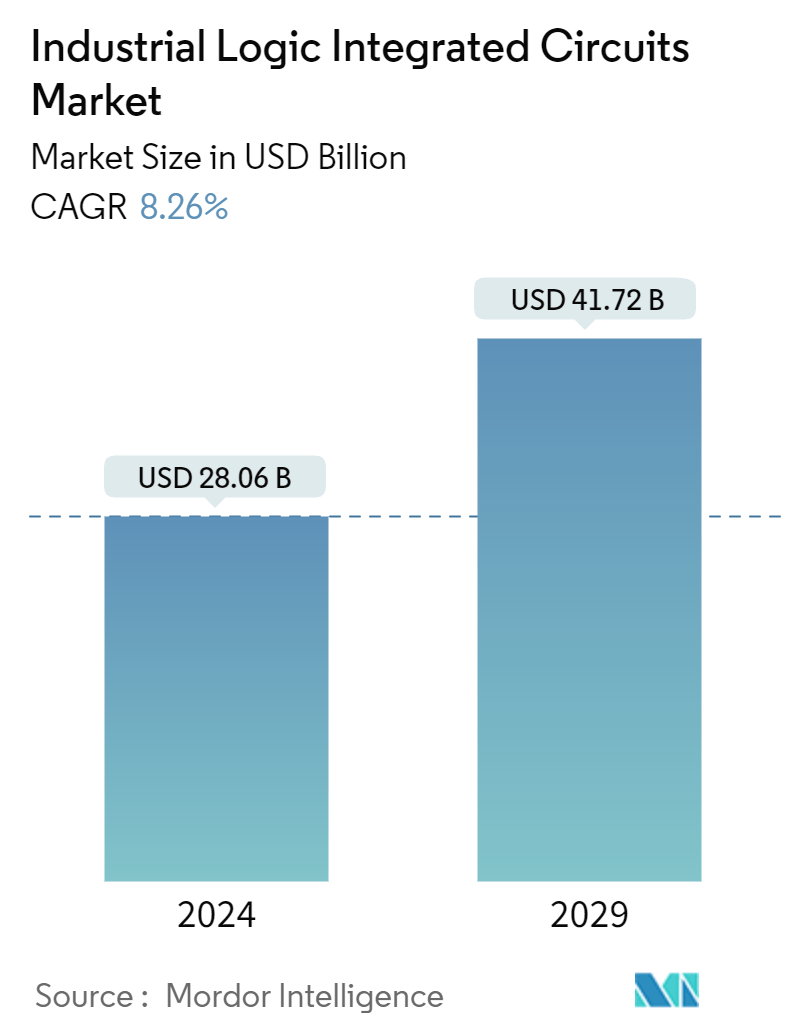
| Study Period | 2018 - 2029 |
| Base Year For Estimation | 2023 |
| Market Size (2024) | USD 28.06 Billion |
| Market Size (2029) | USD 41.72 Billion |
| CAGR (2024 - 2029) | 8.26 % |
| Market Concentration | Low |
Major Players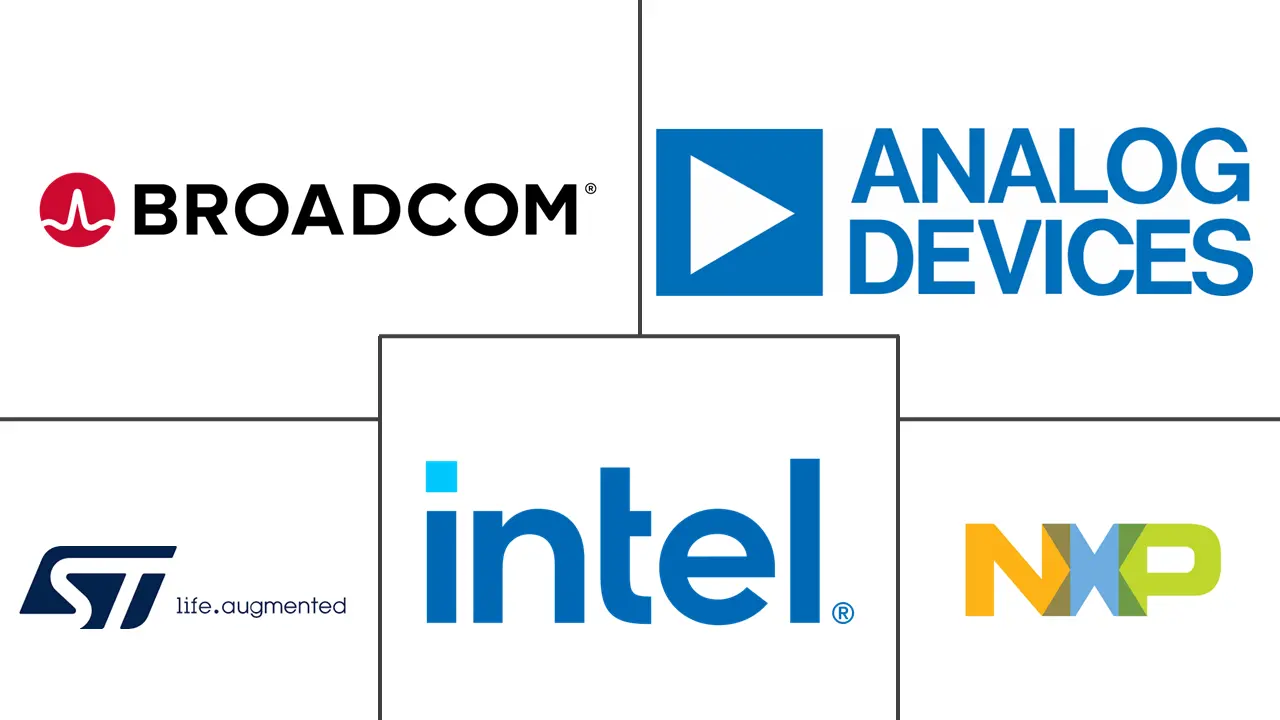
*Disclaimer: Major Players sorted in no particular order |
Industrial Logic Integrated Circuits Market Analysis
The Industrial Logic Integrated Circuits Market size is estimated at USD 28.06 billion in 2024, and is expected to reach USD 41.72 billion by 2029, growing at a CAGR of 8.26% during the forecast period (2024-2029).
- Logic integrated circuits (ICs) are specialized semiconductor devices that perform logical operations on digital signals. These operations include fundamental functions such as AND, OR, and NOT, which are the building blocks of digital circuits. Advances in semiconductor technology have led to the evolution of more compact, energy-efficient, and high-performance logic circuits. The introduction of smaller nodes in IC manufacturing enables the integration of more functionalities into a single chip, which is crucial for applications requiring space-saving solutions.
- The upsurge in the adoption of the Internet of Things (IoT) has spurred the need for smarter and connected devices, further propelling the demand for advanced logic ICs that can handle complex computations and data processing.
- As industries strive to enhance productivity and reduce operational costs, the shift toward automation is a prominent market driver. Logic ICs play a pivotal role in automating manufacturing processes by controlling machinery, sensors, and communication systems. The need for precision and reliability in automated systems has led to an increasing demand for high-quality logic ICs capable of handling real-time data processing and decision-making. The ongoing trend of Industry 4.0, which emphasizes smart manufacturing and interconnected systems, is bolstering the adoption of advanced logic ICs.
- The proliferation of industrial robots is another critical driver for the logic IC market. These robots require sophisticated control systems powered by logic ICs to perform tasks such as assembly, welding, and material handling. The increasing complexity of robotic applications, coupled with the demand for collaborative robots (cobots) that work alongside human operators, necessitates the use of advanced logic circuits. As industries continue to invest in robotic automation to improve efficiency and safety, the demand for logic ICs in robotics applications is expected to surge.
- On the other hand, the rapid pace of technological advancements, leading to frequent obsolescence and requiring continuous investment in R&D, is expected to restrain the growth of the market. Stringent regulations and compliance standards can increase operational costs and complicate product development.
- Further, the increased inflation and interest rates reduced consumer spending, hampered the demand for semiconductors, electronics, and robotics, and led to slow growth of the market. Further, the United States and China trade war disturbed the global semiconductor supply chain. Owing to strict export and import controls on China by the United States for semiconductor manufacturing equipment, the production of the consumer electronics sector is compromised, thereby affecting the manufacturing and factory automation industries.
- The Russia-Ukraine War has negatively impacted the supply of specific raw materials used in semiconductor manufacturing, such as neon and palladium. These materials are critical inputs for certain stages of the manufacturing process, thereby restraining the growth of the market studied.
Industrial Logic Integrated Circuits Market Trends
The MOS Logic Segment is Anticipated to Hold a Major Market Share
- Metal-oxide-semiconductor (MOS) logic integrated circuits (ICs) have revolutionized the industrial segment, particularly in manufacturing, factory automation, and industrial robotics. Their unique properties, such as low power consumption, high noise immunity, and scalability, render them essential in various industrial sector applications.
- MOS logic ICs play a pivotal role in manufacturing process control systems. They enable precise monitoring and control of machinery and equipment, ensuring optimal operation and minimizing downtime. Through programmable logic controllers (PLCs) that leverage MOS ICs, manufacturers can automate complex processes, such as assembly lines, material handling, and quality control. These systems utilize MOS technology to execute logic operations, enhancing production efficiency and product quality.
- MOS logic ICs are integral to developing smart manufacturing systems in factory automation. They facilitate communication between various automated systems, such as sensors, actuators, and controllers. MOS technology enables the implementation of real-time data processing, allowing for quick decision-making and adaptive responses to changing conditions on the factory floor. For instance, MOS-based systems can manage inventory levels, monitor equipment health, and optimize production schedules, reducing waste and increasing operational efficiency.
- Industrial robots heavily rely on MOS logic ICs for their control systems. These ICs enable complex algorithms that govern robot movement, path planning, and task execution. MOS technology allows for the integration of multiple sensors and feedback systems, enabling robots to perform tasks with high precision and reliability. They are employed in several applications, such as welding, painting, assembly, and material handling, where robots equipped with MOS technology can adapt to various manufacturing environments and improve productivity.
- MOS logic ICs are fundamental to embedded systems used in industrial applications. These systems often require dedicated control over specific tasks, such as monitoring manufacturing processes' temperature, pressure, or flow rates. MOS technology provides the necessary computational power while maintaining compact size and low power consumption, which is crucial in embedded applications.
- Effective communication among different components in a manufacturing environment is vital. MOS logic ICs are used in various communication protocols, such as Modbus, CAN, and Ethernet, facilitating data exchange between machines, sensors, and control units. This interconnectedness is essential for achieving Industry 4.0 standards, where data-driven decision-making enhances flexibility and responsiveness in manufacturing processes.
- MOS logic ICs are pivotal in developing effective communication networks within the industrial sector's 5G framework. By processing data closer to the source, these ICs reduce latency and improve response times, which is critical for applications requiring real-time data processing.
- According to Ericsson, there were an estimated 2.17 billion 5G mobile subscriptions worldwide in 2024, up from just 1.58 billion the previous year. This figure is expected to exceed 5.56 billion by the end of the decade, with 5G set to surpass 4G as the world's leading mobile network technology. The increasing penetration of 5G is expected to drive the growth of the market studied.
- Further, according to 5G Americas, in the first quarter of 2024, the global adoption of 5G connections continued its steady climb, reaching approximately two billion with an addition of 185 million new connections. North America spearheads the global 5G adoption wave, accounting for 32% of all wireless cellular connections in the region. In a robust first-quarter performance, North America bolstered its 5G landscape by adding 22 million new connections. As of Q1 2024, the tally of 5G connections in North America reached an impressive 220 million.
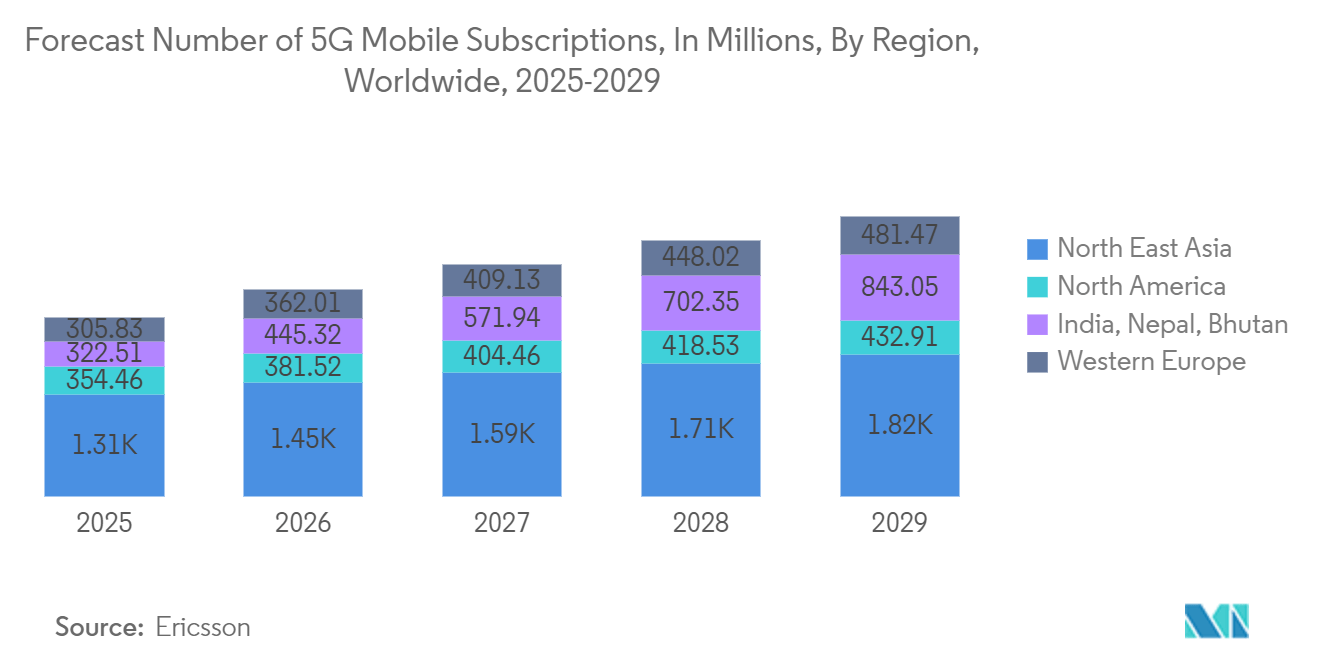
China is Expected to Witness Robust Market Growth Rate
- China's industrial sector stands as a global economic powerhouse, marked by a dynamic blend of manufacturing, factory automation, and the rapidly evolving realm of industrial robotics. Over the past few decades, this diverse sector has been reshaped by technological innovations, government initiatives, and pressing economic needs.
- China, often dubbed the "world's factory," has earned this distinction due to its vast manufacturing capabilities and competitive labor costs. The nation's manufacturing landscape is broad, spanning industries from textiles and electronics to machinery and automotive.
- The country has heavily invested in infrastructure, creating vast networks of transportation and logistics that facilitate the swift movement of goods. The availability of a skilled labor force and government support for high-tech industries has positioned China as a leader in advanced manufacturing. The "Made in China 2025" initiative exemplifies this commitment, aiming to upgrade the manufacturing sector by emphasizing innovation, quality, and sustainability.
- According to the National Bureau of Statistics of China, the revenue of the Chinese manufacturing industry is projected to amount to approximately USD 885.68 billion by 2025. Further, in 2023, China's industrial production increased by about 4.6% compared to the previous year. The robust manufacturing sector in China is likely to drive the growth of the market studied.
- Factory automation has emerged as a critical component of China's industrial strategy. The adoption of automation technologies has enabled manufacturers to enhance productivity, improve quality, and reduce operational costs. Automation is not merely a trend; it has become important for companies to remain competitive in a rapidly changing global market.
- The Chinese government has been a significant proponent of factory automation, recognizing its potential to drive economic growth. Policies and initiatives have been implemented to encourage the adoption of advanced technologies, such as the Industrial Internet of Things (IIoT), big data analytics, and artificial intelligence (AI). These technologies enable manufacturers to optimize production processes, monitor equipment performance in real-time, and predict maintenance needs, thus minimizing downtime.
- Integrating automation technologies has facilitated the movement toward "smart factories." These factories leverage interconnected devices and systems to streamline operations, improve decision-making, and create a more flexible production environment. As a result, Chinese manufacturers are increasingly able to respond to market demands with agility, producing customized products at scale.
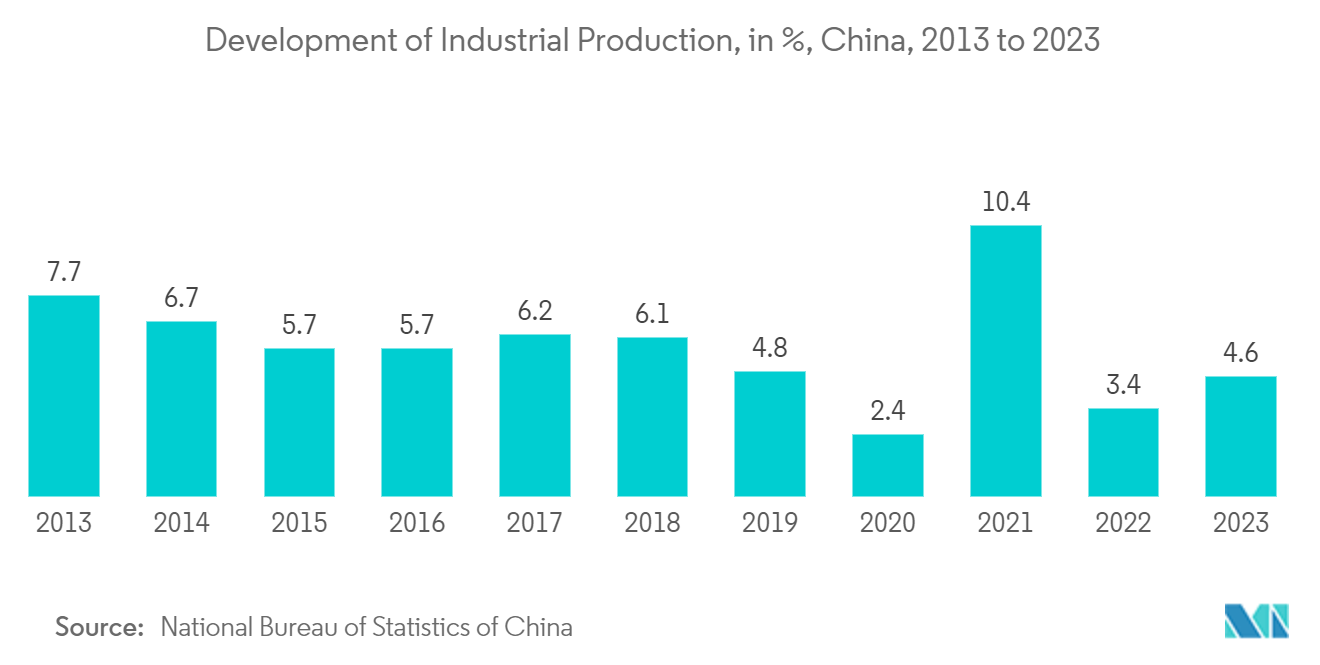
Industrial Logic Integrated Circuits Industry Overview
The industrial logic integrated circuits market is fragmented, with the presence of several major players, such as Analog Devices Inc., Texas Instruments Inc., Intel Corporation, STMicroelectronics NV, Broadcom Inc., etc. These market players are striving to innovate new products through extensive investments in R&D, collaborations, and mergers to cater to consumers' evolving demands.
• December 2023: Toshiba Corporation announced the expansion of its new product lineup in CMOS Logic ICs. It has extended the CMOS Logic and One-gate Logic lineup with an extended operating temperature range up to Ta = 125°C. Toshiba plans to increase general-purpose CMOS logic products and high-temperature guaranteed One-gate Logic(L-MOS), bus switch, and Level shifter products.
• December 2023: Siemens AG, a prominent technology firm, partnered with Intel Corporation, a global semiconductor giant, through a signed Memorandum of Understanding. Their collaboration aims to propel the digitalization and sustainability of microelectronics manufacturing. Both companies will enhance future manufacturing initiatives, refine factory operations and cybersecurity measures, and bolster a resilient global industry ecosystem.
Industrial Logic Integrated Circuits Market Leaders
-
STMicroelectronics N.V.
-
Analog Devices Inc.
-
Broadcom Inc.
-
Intel Corporation
-
NXP Semiconductors N.V.
*Disclaimer: Major Players sorted in no particular order
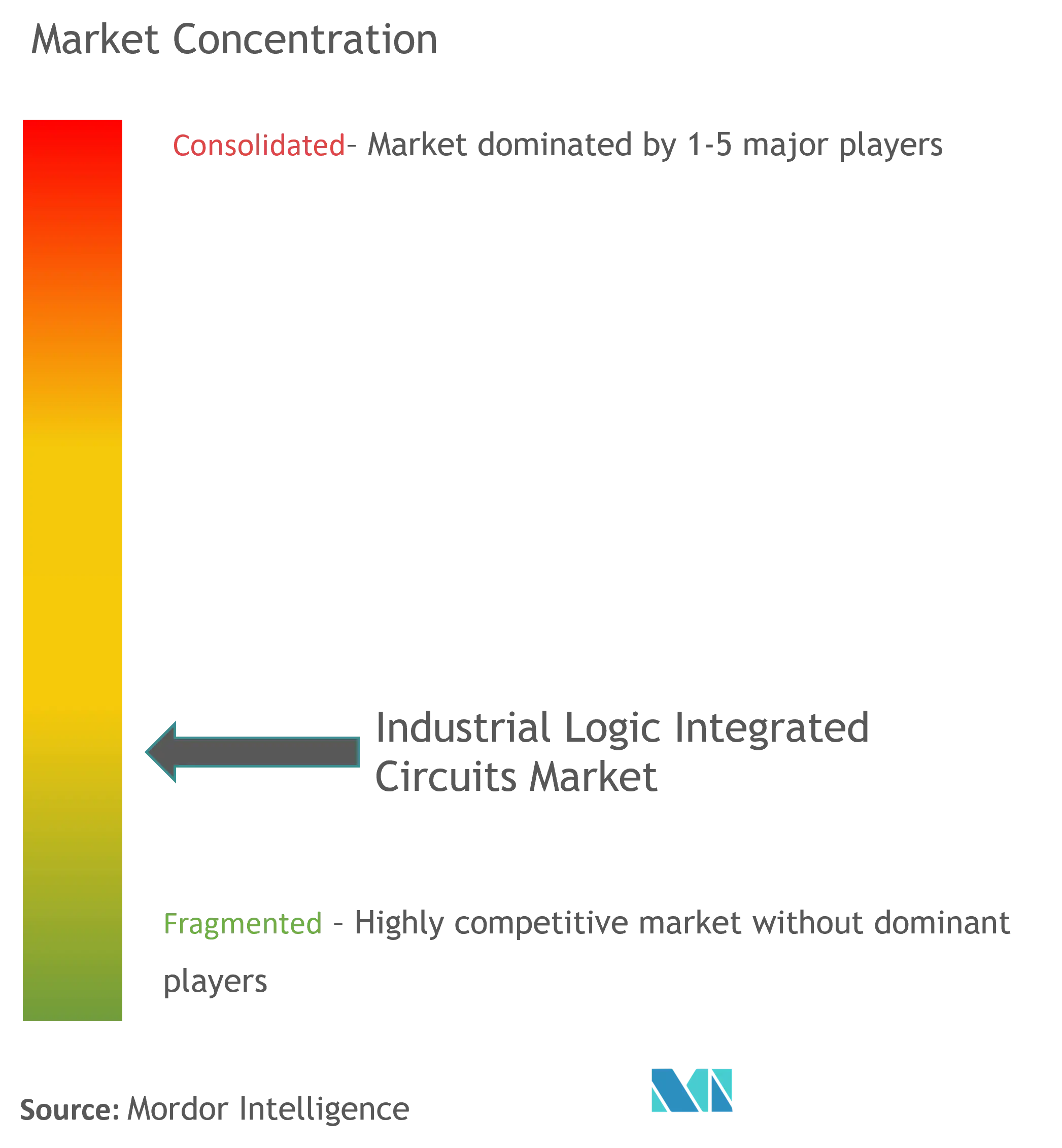
Industrial Logic Integrated Circuits Market News
- June 2024: STMicroelectronics unveiled its plan to construct an advanced manufacturing facility in Catania, Italy, dedicated to producing power devices and modules using 200mm silicon carbide (SiC) technology. The facility is also claimed to include testing and packaging facilities. According to the company, the establishment is a significant achievement aimed at assisting customers in utilizing SiC devices in many sectors, such as industrial, communications, consumer, and cloud infrastructure.
- October 2023: Samsung Electronics Co. Ltd, a prominent advanced semiconductor technology company, unveiled its latest analog and logic semiconductor technology innovations and outlined its blueprint for technological advancements at the Samsung System LSI Tech Day event. With comprehensive logic solutions tailored for various industries, Samsung emphasized its vision to lead hyper-connected, hyper-intelligent, and hyper-data technologies in the Fourth Industrial Revolution era.
Industrial Logic Integrated Circuits Market Report - Table of Contents
1. INTRODUCTION
- 1.1 Study Assumptions and Market Definition
- 1.2 Scope of the Study
2. RESEARCH METHODOLOGY
3. EXECUTIVE SUMMARY
4. MARKET INSIGHTS
- 4.1 Market Overview
-
4.2 Industry Attractiveness - Porter's Five Forces Analysis
- 4.2.1 Bargaining Power of Suppliers
- 4.2.2 Bargaining Power of Consumers
- 4.2.3 Threat of New Entrants
- 4.2.4 Threat of Substitute Products
- 4.2.5 Intensity of Competitive Rivalry
- 4.3 Industry Value Chain Analysis
- 4.4 Impact of COVID-19 Aftereffects and Other Macroeconomic Factors on the Market
5. MARKET DYNAMICS
-
5.1 Market Drivers
- 5.1.1 Increasing Focus on Device Integration
- 5.1.2 Increasing Capital Expenditures of Fabs to Augment Production Capacity
- 5.1.3 Increase in Factory Automation
-
5.2 Market Restraint
- 5.2.1 Complexity Associated with Logic IC Design
6. MARKET SEGMENTATION
-
6.1 By IC Type
- 6.1.1 Digital Bipolar
- 6.1.2 MOS Logic
- 6.1.2.1 MOS General Purpose
- 6.1.2.2 MOS Gate Arrays
- 6.1.2.3 MOS Drivers/Controllers
- 6.1.2.4 MOS Standard Cells
- 6.1.2.5 MOS Special Purpose
-
6.2 By Geography***
- 6.2.1 United States
- 6.2.2 Europe
- 6.2.3 Japan
- 6.2.4 China
- 6.2.5 South Korea
- 6.2.6 Taiwan
- 6.2.7 Latin America
- 6.2.8 Middle East and Africa
7. COMPETITIVE LANDSCAPE
-
7.1 Company Profiles
- 7.1.1 STMicroelectronics NV
- 7.1.2 Analog Devices Inc.
- 7.1.3 Intel Corporation
- 7.1.4 Texas Instruments Inc.
- 7.1.5 Renesas Electronics Corporation
- 7.1.6 Broadcom Inc.
- 7.1.7 Diodes Incorporated
- 7.1.8 NXP Semiconductors NV
- 7.1.9 Toshiba Corporation
- 7.1.10 On Semiconductor Corporation
- *List Not Exhaustive
8. INVESTMENT ANALYSIS
9. FUTURE OF THE MARKET
** Subject To AvailablityIndustrial Logic Integrated Circuits Industry Segmentation
Logic integrated circuits (ICs) are specialized semiconductor devices that perform logical operations on digital signals. These operations include fundamental functions such as AND, OR, and NOT, which are the building blocks of digital circuits.
For market estimation, the revenue generated from sales of various types of industrial logic integrated circuits like digital bipolar and MOS logic across a diverse range of geographic regions worldwide is tracked. Market trends are evaluated by analyzing product innovation, diversification, and expansion investments. Enhancements in energy efficiency, artificial intelligence, miniaturization, machine learning, manufacturing process control, embedded & communications systems, etc., are also crucial in determining the growth of the market studied.
The industrial logic integrated circuits market is segmented by IC type (digital bipolar and MOS logic [MOS general purpose, MOS gate arrays, MOS drivers/controllers, MOS standard cells, and MOS special purpose]), and geography (United States, Europe, Japan, China, Korea, Taiwan, and rest of the world). The market sizes and forecasts are provided in terms of value (USD) for all the above segments.
| By IC Type | Digital Bipolar | |
| MOS Logic | MOS General Purpose | |
| MOS Gate Arrays | ||
| MOS Drivers/Controllers | ||
| MOS Standard Cells | ||
| MOS Special Purpose | ||
| By Geography*** | United States | |
| Europe | ||
| Japan | ||
| China | ||
| South Korea | ||
| Taiwan | ||
| Latin America | ||
| Middle East and Africa |
Industrial Logic Integrated Circuits Market Research FAQs
How big is the Industrial Logic Integrated Circuits Market?
The Industrial Logic Integrated Circuits Market size is expected to reach USD 28.06 billion in 2024 and grow at a CAGR of 8.26% to reach USD 41.72 billion by 2029.
What is the current Industrial Logic Integrated Circuits Market size?
In 2024, the Industrial Logic Integrated Circuits Market size is expected to reach USD 28.06 billion.
Who are the key players in Industrial Logic Integrated Circuits Market?
STMicroelectronics N.V., Analog Devices Inc., Broadcom Inc., Intel Corporation and NXP Semiconductors N.V. are the major companies operating in the Industrial Logic Integrated Circuits Market.
What years does this Industrial Logic Integrated Circuits Market cover, and what was the market size in 2023?
In 2023, the Industrial Logic Integrated Circuits Market size was estimated at USD 25.74 billion. The report covers the Industrial Logic Integrated Circuits Market historical market size for years: 2018, 2019, 2020, 2021, 2022 and 2023. The report also forecasts the Industrial Logic Integrated Circuits Market size for years: 2024, 2025, 2026, 2027, 2028 and 2029.
Industrial Logic Integrated Circuits Industry Report
Statistics for the 2024 Industrial Logic Integrated Circuits market share, size and revenue growth rate, created by Mordor Intelligence™ Industry Reports. Industrial Logic Integrated Circuits analysis includes a market forecast outlook for 2024 to 2029 and historical overview. Get a sample of this industry analysis as a free report PDF download.



